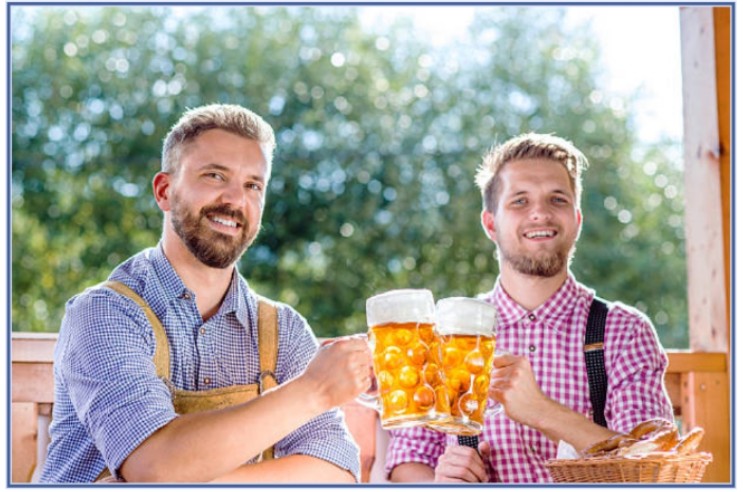When it comes to Bavarian culture, one of the first images that comes to mind is the traditional attire worn at Oktoberfest. Central to this attire is the Oktoberfest lederhosen, a distinctive pair of leather shorts that have become synonymous with Bavarian culture and the world-renowned festival. But the lederhosen isn’t just a fashion statement; it’s a piece of history embedded in the rich tradition of trachten, which refers to the traditional garments worn in the Alpine regions of Germany, Austria, and Switzerland. This article explores the origins, evolution, and cultural significance of Oktoberfest lederhosen and trachten, delving into how these garments have stood the test of time, reflecting both Bavarian pride and heritage.
The Origin of Bavarian Lederhosen
The history of trachten and Oktoberfest lederhosen dates back centuries, long before the festival gained its worldwide popularity. Lederhosen, which translates to “leather pants,” originated in the Alpine regions as practical workwear. Made from durable deerskin or goatskin, they were worn by peasants, farmers, and hunters due to their durability and ease of movement. In the 16th century, the lederhosen began to emerge as a staple of trachten, the broader term for traditional Bavarian clothing. Trachten not only signified a person’s social status but also their region of origin. In Bavaria, the Oktoberfest lederhosen became a crucial part of the male trachten, a practical outfit for the hard-working rural class. Interestingly, the lederhosen also evolved from an earlier form of clothing known as “culottes,” which were worn by European aristocracy. However, the Bavarians adapted the design to meet their specific needs for outdoor work, thus creating what we now know as Oktoberfest lederhosen. These garments were tailored for longevity, featuring suspenders for added support, decorative embroidery that reflected regional pride, and leather that withstood the rugged Alpine environment.
Lederhosen Becomes a Fashion Trend
By the late 18th and early 19th centuries, Oktoberfest lederhosen had evolved from functional work attire into a fashion statement. The rise of Romanticism across Europe brought with it a fascination with nature, tradition, and rural life. Bavarians, proud of their heritage, began to embrace the trachten and lederhosen as symbols of cultural identity. During this period, it was common to see members of the aristocracy donning lederhosen as they engaged in outdoor activities like hunting and hiking. The lederhosen became an essential part of Bavarian society, not only as traditional workwear but as an indicator of cultural pride. This shift helped cement its status as an integral component of trachten. Over time, it was no longer just the working class who wore these garments; they became fashionable among the upper echelons of Bavarian society, particularly during celebrations and festivals.
This newfound popularity of Oktoberfest lederhosen laid the foundation for its association with the world-famous Oktoberfest. At the start of the 19th century, lederhosen had firmly established itself as the go-to attire for Bavarian men attending cultural festivities, further solidifying its importance in trachten.
From Downfall of Lederhosen to Becoming the Official Oktoberfest Outfit
Despite its early popularity, the Oktoberfest lederhosen saw a significant decline in the late 19th and early 20th centuries. Industrialization had transformed Europe, and many people began to leave their rural lifestyles behind in favor of urban living. Traditional clothing like lederhosen and trachten were viewed as old-fashioned and unsuitable for modern city life. As a result, fewer Bavarians donned the traditional attire, and it seemed as though the Oktoberfest lederhosen might fade into history. However, this trend began to reverse in the early 20th century, thanks in large part to organizations dedicated to preserving Bavarian culture. One such organization, the “Bayerischer Trachtenverein,” was formed to promote the wearing of trachten and lederhosen as symbols of Bavarian identity. These efforts coincided with a growing sense of Bavarian nationalism, and soon the Oktoberfest lederhosen became a symbol of regional pride. By the mid-20th century, lederhosen had regained its popularity, this time with a more modern twist. While still rooted in tradition, new variations of lederhosen began to appear. Shorter versions, known as Oktoberfest lederhosen shorts, became particularly popular at the annual Oktoberfest in Munich. Today, it is almost impossible to imagine Oktoberfest without the sight of men proudly wearing their lederhosen, further solidifying its place in trachten culture.
Efforts to Preserve the Bavarian Lederhosen
One of the key reasons that Oktoberfest lederhosen and trachten have remained relevant today is the concerted effort by Bavarians to preserve these traditions. Over the past few decades, numerous organizations and festivals have sprung up with the sole purpose of promoting Bavarian cultural heritage, with lederhosen at the forefront. At the heart of these preservation efforts is the idea that trachten represents more than just clothing; it is a symbol of Bavarian identity. Many Bavarians, particularly those in rural areas, still wear lederhosen for special occasions, weddings, and of course, Oktoberfest. Additionally, Bavarian schools often encourage the teaching of trachten and traditional customs, ensuring that future generations remain connected to their cultural roots. The resurgence of Oktoberfest lederhosen is also credited to fashion designers who have embraced the traditional aesthetic, reinterpreting it in modern ways. High-quality lederhosen are now seen as fashionable and prestigious garments, often worn not just at Oktoberfest but also at other cultural and social events around the world.
A Detailed Look Into Lederhosen – Ideal Materials, Colors, Lengths & Pairing
The key to understanding Oktoberfest lederhosen lies in the details. Authentic lederhosen are made from high-quality leather, typically sourced from deer, goat, or cowhide. Deerskin is particularly prized for its softness and durability, which makes it an excellent choice for long-lasting lederhosen. Goatskin is also popular due to its lightweight nature and sleek appearance. In terms of color, traditional Oktoberfest lederhosen tend to come in shades of brown, black, or dark green. However, modern versions have expanded the color palette to include lighter tones like tan and gray. The embroidery on lederhosen often matches the color of the leather or provides a contrasting accent that highlights the craftsmanship. The length of lederhosen can vary depending on personal preference and occasion. The most common style worn at Oktoberfest is the short lederhosen, which ends just above the knee. This style is ideal for warmer weather and is commonly paired with a traditional white or checkered shirt. Another option is the bundhosen, which is a longer version of the lederhosen, extending to mid-calf. This style is often worn in cooler weather or for more formal occasions. When it comes to pairing, Oktoberfest lederhosen are typically worn with knee-high wool socks, sturdy shoes called Haferlschuhe, and a wool or felt hat known as a Tirolerhut. For an extra touch of authenticity, many men also add suspenders and a leather belt to their ensemble.
What is Bundhosen? What Materials Are Lederhosen & Bundhosen Made From?
As mentioned earlier, bundhosen are a longer version of lederhosen that extend to mid-calf. While lederhosen are more commonly worn at Oktoberfest, bundhosen are also considered an important part of trachten and are often worn for formal events or in colder weather. Both lederhosen and bundhosen are made from similar materials, typically high-quality leather such as deerskin, goatskin, or cowhide. The choice of material plays a crucial role in the comfort, durability, and overall appearance of the garment. Deerskin is widely regarded as the premium material for lederhosen and bundhosen, thanks to its soft texture and long-lasting nature.
In addition to leather, other materials are used to complete the traditional lederhosen look. For example, the suspenders and belts are often made from the same leather as the pants, while the shirts and socks are usually crafted from natural fibers like cotton and wool.
What is the Significance of Embroidery on Traditional Lederhosen?
One of the most distinctive features of Oktoberfest lederhosen is the intricate embroidery that adorns the pants. These embroidered patterns are not merely decorative; they hold significant cultural meaning. The designs often represent the wearer’s region of origin or family heritage. Common motifs include floral patterns, animals like deer or eagles, and other natural symbols. In traditional Bavarian culture, the embroidery on lederhosen was a way to show regional pride and craftsmanship. Each region had its own distinct patterns, allowing Bavarians to identify where someone was from simply by looking at their lederhosen. Today, the embroidery remains an essential element of trachten, with many modern lederhosen featuring a combination of traditional and contemporary designs. High-quality lederhosen from reputable brands like eLederhosen often feature hand-stitched embroidery, which adds an extra layer of authenticity and craftsmanship to the garment. Whether simple or elaborate, the embroidery on Oktoberfest lederhosen serves as a reminder of the garment’s deep cultural roots.
What Accessories Complete the Traditional Lederhosen Look?
No Oktoberfest lederhosen ensemble is complete without the right accessories. These additions not only enhance the overall look but also provide functional benefits, ensuring that the wearer is both stylish and comfortable.
- Tirolerhut: The traditional Bavarian hat, known as a Tirolerhut, is often worn with lederhosen. These hats are typically made from felt or wool and are adorned with feathers or decorative pins.
- Haferlschuhe: These sturdy leather shoes are designed to be worn with lederhosen. Haferlschuhe are durable and provide good traction, making them perfect for walking around the festival grounds.
- Wool Socks: Knee-high wool socks are a common pairing with lederhosen. They add warmth and comfort, especially if you’re attending Oktoberfest in cooler weather.
- Suspenders: Most lederhosen come with suspenders, which are both functional and decorative. The suspenders help keep the pants in place and often feature embroidery that matches the design on the lederhosen.
By incorporating these accessories into your outfit, you’ll not only look the part but also feel fully immersed in the trachten tradition.
Final Thoughts – Is the Lederhosen Tradition Preserved?
The enduring popularity of Oktoberfest lederhosen and trachten is a testament to the resilience of Bavarian culture. Despite the pressures of modernization and globalization, the people of Bavaria have managed to preserve their unique heritage, ensuring that lederhosen remains an integral part of their identity. Today, Oktoberfest lederhosen are worn by people of all ages, both in Bavaria and around the world. From the grand tents of Oktoberfest in Munich to smaller celebrations in cities across the globe, the tradition of wearing lederhosen continues to thrive. Brands like eLederhosen play a significant role in this preservation, offering high-quality garments that honor the authenticity and craftsmanship of traditional lederhosen.
In conclusion, the Oktoberfest lederhosen are more than just a piece of clothing; they are a symbol of Bavarian pride, culture, and history. As part of the broader trachten tradition, lederhosen continue to be worn with pride, serving as a reminder of the rich heritage that defines Bavaria and its people.


